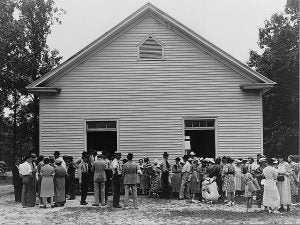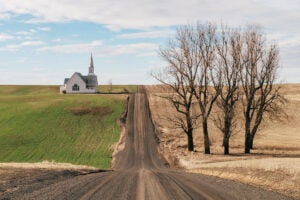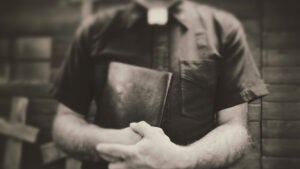Editor’s Note: This is the first in a three-part series discussing faith and religious participation in rural America. The explorative series, titled Religion in the Heartland. is an AGDAILY exclusive.
The changing face of America continues to dominate national and even global conversations. And probably nowhere does the topic boil hotter than with the question of religion. Depending on what you’re reading, you might get the feeling that the U.S. is either becoming a Christian theocracy or an atheist state.
Where from the Puritan colonists of the Netherlands and British Isles, the Roman Catholic missionaries in the south and west, the holy lands of Native Americans, or the temples of Jewish, Muslim, and other immigrants, religion was a cornerstone of the American experience long before the United States came into being. After all, without William Penn’s Quakers, would there be a Pennsylvania? Would there be a San Francisco without Saint Francis?
Some argue that relationship between religion and Americana is changing. Others say it’s impossible to remove religion from a nation built by those seeking religious freedom.

If you’re reading this and wondering what all the fuss is about, it could be because, well, you’re living in rural America, and according to recent studies, you’re in an area that remains a relative hotbed of faith. But you’ve undoubtedly noticed by now that your suburban and urban neighbors aren’t quite doing the same thing on Sunday morning. It would seem that among the gaps within the U.S., few are greater than those between the rural, suburban, and urban communities when it comes to religion. And yes, as you’d suspect, those birds fly together with politics, race, and ethnicity.
But first, some definitions
Right or wrong, when someone plugs the terms rural America and faith into a conversation, the first religion that probably comes to mind is Christianity. This isn’t to say there aren’t practitioners of other faiths living here, but in terms of percentages, their numbers remain in the single digits. What you’ll find in the Pew Research studies, the 2022 American Communities Project and the Public Religion Research Institute’s 2020 Census of American Religion is that yes indeed, the areas classified as rural in America remain overwhelmingly Christian amidst a nation where the term “none of the above” is rising quickly around them. And with rural populations both graying and shrinking as a whole relative to the suburban and urban, that presents a slightly different picture than in decades past.
It’s a point of interest to me that in the national studies I’ve read on this topic, the categories racial/ethnic and religious are intertwined. Although technically those two demographics are distinct, you’ll see in survey after survey that the researchers combine them. Categories reported include:
- White evangelical Protestant
- White mainline non-evangelical Protestant
- White Roman Catholic
- Church of Jesus Christ Latter-Day Saints (Mormom)
- Orthodox Christian
- Black Protestant
- Hispanic/Latino Protestant
- “Other” Protestant of color
- Hispanic/Latino Roman Catholic
- “Other” Roman Catholic of color
- Jehovah’s Witness
- Jewish
- Muslim
- Buddhist
- Hindu
- Unitarian/Universalis
- “Other”
- Unaffiliated and Don’t Know
In addition to urban and suburban categories, these reports break down what most of consider to be rural America into several overlapping zones like “Graying America,” “Rural Middle America,” and “Aging Farmlands.”
Rural America today
As of 2020, 70 percent of the U.S. population identified as Christian, with 23 percent declaring themselves unaffiliated, and about 1 percent each in the categories of Jewish, Muslim, Buddhist, and Hindu. Back in the 1990s, the Christian population was about 90 percent. According to the PRRI 2020 Census of American Religion, about 80 percent of the residents in rural America identify as Christian. The report, which I highly recommend reading in detail if you’re interested, is presented in a county-by-county manner and reports 83 percent Christian in the “Aging Farmlands,” 83 percent Christian in the “Evangelical Hubs,” 80 percent Christian in the “Working Class Country,” 78 percent Christian in “Rural Middle America,” and 73 percent Christian in “Graying America.”

Meanwhile, Christians account for about 67 percent of those living in “Big Cities,” 68 percent in the “Urban Suburbs,” 75 percent in the “Middle Suburbs,” and 76 percent in the “Exurbs.” The racial makeup of the Christian communities is what really tells the story though, with the rural Americans being 61-78 percent White, compared to only 33 percent White in the “Big Cities,” 40 percent in the “Urban Suburbs,” 63 percent in “Middle Suburbs,” and 61 percent in the “Exurbs.” The 34 percent of Christians in the “Big Cities” are largely African-American and Hispanic/Latino.
One point of note here, keep in mind the difference in populations between the cities, suburbs, and rural counties. The 2020 population of Chicago was tabbed at 2.7 million. Meanwhile, Marshall County, Illinois, had a population of 11,742 in the same year. So the rural communities certainly have higher percentages of faithful, but one can’t discount the gross numbers of the suburbs and cities.
In 2020, White Christians from all categories comprised 44 percent of the U.S. population. There are highest concentrations were in rural America, primarily the Midwest. The median age of White Christians is 53 years old. The top five highest concentrations of White Christians in counties with more than 10,000 residents were:
- Lyon County, Iowa (87%)
- Meeker County, Minnesota (86%)
- Redwood County, Minnesota (86%)
- Mercer County, Ohio (86%)
- Madison County, Idaho (85%)
Meanwhile, Black Protestant Christians, who comprise 7 percent of the U.S. population, were most heavily concentrated in the South and Southeast and their median age is 50. The top five highest concentrations of Black Protestant Christians in counties with more than 10,000 residents were:
- Holmes County, Mississippi (68%)
- Noxubee County, Mississippi (66%)
- Bullock County, Alabama (63%)
- Macon County, Alabama (62%)
- Coahoma County, Mississippi (61%)
Hispanic/Latino Protestants comprise 4 percent of the U.S. with a median age of 39. The top five concentrations of Hispanic/Latinos in counties with populations in excess of 10,000 in the U.S. include:
- Hidalgo County, Texas (21%)
- Maverick County, Texas (20%)
- Zavala County, Texas (18%)
- Cameron County, Texas (18%)
- Zapata County, Texas (17%)
Hispanic/Latino Roman Catholics made up 8 percent of the U.S. in 2020 with a median age of 42. The top five highest concentrations in the U.S. counties with more than 10,000 include:
- Zapata County, Texas (59%)
- Starr County, Texas (58%)
- Webb County, Texas (57%)
- Maverick County, Texas (55%)
- Santa Cruz County, Arizona (52%)
Jewish, Muslim, Buddhist, and Hindu Americans each comprise about 1 percent of the population and reported living primarily in suburban and urban areas. But the category that seems to be growing the fastest throughout the U.S. is that of the “Religiously Unaffiliated,” marked at 23 percent of the population, with a median age of 38, and 39 percent in urban areas, 44 percent in suburban areas, and 17 percent in rural areas.
What’s the difference?
The difference is actually quite stark. In the early 1990s, about 90 percent of all U.S. adults identified as Christians. And as the trendline goes, it’s the category of “unaffiliated” that is growing rather than other faiths. The concept of transmission seems to be one of the arguments for this change, and farmers will understand this quite well. The younger generation is more likely to identify as “unaffiliated” because the faith was not transmitted to them by their parents. Much like multi-generational farms now being sold off, somewhere along the line, the kids grew up without a desire to carry on as their ancestors had. To that extent, rural America and the community of faith have a lot in common, with an aging population and a generation of kids and grandkids that aren’t switching teams per se but choosing not to participate.

Another interesting point of note by researchers at the Pew Research Center was that 70 percent of adults who had been raised Christian but now claim “unaffiliated” are Democrat or Democrat-leaning independents, which led them to observe that there’s a growing perception that the community of faith is linked to both conservative politics and, yes, rural communities.
My own observation is that of overall population number and age here. In 1990, the U.S. population was 250 million, compared to 330 million in 2020. In 1990, the media age in the U.S. was 32.9 years old, compared to 29.5 in 1960, and continuing that trend upwards today at about 39. So, in simple math, if 70 percent of the 330 million Americans in 2020 identify as Christian, that amounts to about 231,000,000, compared to 90 percent of the 250 million Americans in 1990, which would be about 225 million. But those simple numbers don’t tell the story about age and changing attitudes between the generations. We’d have to assume that children in a household are identifying with the faith of their parents and clearly that’s not the case at all. Much like farm ownership, which in the early 1900s accounted for upwards of 90 percent of employment, the continuance of faith is a decision made with each generation. Consider that demographers expect the U.S. population to be about 450 million in 2050. If that’s the case, even a 50 percent Christian country would possess 225 million people, roughly the same as today and yesteryear. But if that same 450 million citizen nation was 90 percent Christian again, it would be closer to 405 million. The answer to the future clearly lies in the transmission between generations.
Overall, it’s impossible to drive through rural America and not see the relationship between its residents and their communities of faith. The farm and church go together in most people’s minds like baling hay and summer days. But perhaps that’s one of the reasons for the growing ranks of unaffiliated peoples. Perhaps they associate religion too closely with an older way of life. In either case, there’s no question the raw numbers of faith-practicing Americans rivals the population of other nations. But are demographers correct as they predict the trend toward a more secular nation and if that’s the case, is it a shrinking faith base or a growth of population away from religion?
More to come: If you’re reading this now, considering sending me your thoughts at bboyce@verticalscope.com for the second installment set to run next month where I’ll incorporate some of them into the piece. Questions you can help answer include:
-
Do you feel the national pollsters are accurately describing your community?
-
Do you see a decline or upswing in your local community of faith where you live?
-
To what type of community of faith do you belong?
-
Where do you see the country heading in this regard?
In the third installment for October, I’ll discuss more of my own experience growing up in, and now serving in, the Prairie City United Methodist Church, as well as its relevance to these discussions in rural Clay County, Indiana, amid a denominational battle involving thousands of disaffiliating congregations.
Brian Boyce is an award-winning writer living on a farm in west-central Indiana. You can see more of his work at the Boyce Group homepage.



